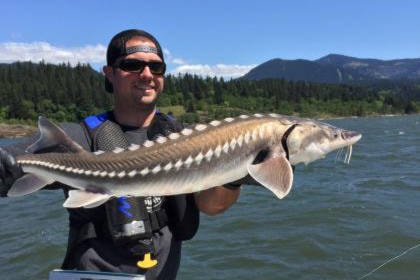Anglers south of the border will be reaping the rewards of BC’s white sturgeon recovery program.
On Saturday, the Washington Department of Fish and Wildlife (WDFW) opened a white sturgeon fishery on Lake Roosevelt.
“This is the third year in a row that anglers have the opportunity to fish for white sturgeon in Lake Roosevelt,” Chris Donley, WDFW Fish Program manager, said in a release. “This is a great opportunity for anglers to get out and pursue one of the greatest native sport-fish in Washington.”
According to Donley, the hatchery-raised sturgeon population is booming just across the line in Columbia’s Lake Roosevelt Reservoir, yet, there is a strict no-angling policy for sturgeon on the Columbia River on the BC side that includes the 50-km stretch from Hugh Keenleyside Dam near Castlegar to the Waneta Border past Trail.
The ancient species, which can grow up to six-metres long and live up to 100-years, is native to the Columbia River and listed as “Endangered” by the Federal Government’s Species at Risk Act (SARA). A concerted effort to recover the threatened species, has been ongoing in BC since 2001. A white sturgeon recovery program has released anywhere from 2,000 to 12,000 juvenile sturgeon annually into the Columbia.
“There is a totally different endangered species act piece on the other (U.S.) side and they haven’t listed them as endangered in the U.S.,” said Matt Neufeld, biologist at the BC Ministry of Forests, Lands, and Natural Resources (FLNRO). “My understanding is related to how you look at their genetics and parse out whether that group is similar to the one downstream of the Columbia. Regardless, we have this different listing status for a species that does move across and of course is part of one larger Upper Columbia sturgeon stock.”
Canadian anglers can take advantage of the U.S. sturgeon fishery and buy a Washington State fishing licence. Many anglers, however, are likely wondering why they have to spend their money across the border, when those same sturgeon were raised and released by a BC Program paid for by BC fishers and tax payers?
“Sturgeon fishing is a big draw, people like to do it, and want to do it, and we’d like to see that happen in the future but at this point, they would have to be delisted by DFO for that to happen.”
There is a long list of criteria in the Federal Government’s Recovery Strategy for that to happen including proving that the sturgeon are naturally recruiting and a natural age structure has been restored.
Original studies showed that there was a gap of about 25 years between young and mature sturgeon so fisheries managers tried to restore that population using a variety of brood stock to get a genetically diverse population.
On the upside, the sturgeon recovery program was successful and Neufeld estimates the population in the Upper Columbia above Grand Coulee Dam to be about 30,000 juvenile sturgeon.
“Those are almost entirely hatchery fish,” said Neufeld. “So about four years ago we had enough data to start looking at - of those hatchery fish, what’s the make up of that population?”
The hatchery program released families in equal numbers, but it turns out a few of those were dominant when it came to survival.
“There were some families, a small number of families, that we released from a few parents, that made up a pretty significant part of that overall estimate of abundance - they were over-represented those families.”
As a response, a collection of government, industry reps, DFO, environmental and stewardship organizations, First Nations, aboriginal organizations, and co-managers’ interests on both sides of the border agreed to take action on the population by removing some of those individuals, said Neufeld, and bring more balance to the population.
To ensure only sturgeon in that particular age group are harvested, WDFW instituted a slot-limit, where only sturgeon between 53 inches and 63 inches can be kept.
Related read: Three Albertans land ‘monster’ sturgeon in B.C.’s Fraser River
BC boasts a popular sturgeon fishery on the Fraser River, a catch-and-release fishery, which is enjoyed by thousands every year, but legally bottom-bouncing for sturgeon on the BC side of the Columbia River is not on the immediate horizon.
“I think in the short term it’s unlikely,” said Neufeld. “Certainly that’s one of the reasons we continue to engage there, not only to recover an endangered species, but there will be opportunities likely in the future for beneficial use.”
The WDFW daily possession limit is one sturgeon per day and an annual limit of two, although anglers may continue to catch and release sturgeon after reaching daily and annual limits.
According to the Species at risk registry, an action plan outlining the measures required to meet the goals and objectives of the sturgeon Recovery Strategy is being developed. Studies on the topics of abundance, genetics, habitat, ecology, aquaculture, life history, and traditional knowledge also continue to inform recovery efforts.
sports@trailtimes.ca
Like us on Facebook and follow us on Twitter
